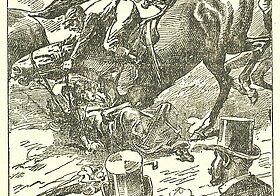Annual maintenance work will take place again this summer, which is why the reading rooms at the Heldenplatz location and in all collections will be closed from Friday, July 25, to Tuesday, August 5, 2025.
Due to the shutdown of the ordering system, no media orders can be accepted from Thursday, July 24, 2025, 4 p.m. to Tuesday, August 5, 2025, 4 p.m. The regular opening hours will then apply again from Wednesday, August 6, 2025.
The study room of the Albertina is closed from July 15 to August 15. During this time (except July 25 to August 5), media ordered from the Albertina collection will be transported twice a week (Monday and Thursday) to the reading rooms of the National Library on Heldenplatz and can be used there.
Starting August 1, 2025, the State Hall will open at 9 a.m.
Due to an event, the State Hall will be closed on August 4, 2025.
A predecessor of the British women’s suffrage activists was the author Mary Wollstonecraft, who demanded equality for women in 1792 in her book “A Vindication of the Rights of Women”. In the 18th century her demands were ignored.
In 1866 Member of parliament John Stuart Mill advocated to parliament that women should be allowed to vote, but without success. In 1869 he published the essay “The Subjection of Women” in which he criticised the injustice of excluding women from the political process. It initiated a public debate and women began to organise.
As a result the National Society for Women’s Suffrage was formed, with regional groups throughout the country. Lydia Becker was among the most prominent members, holding many speeches on women’s suffrage. In 1870 Lydia Becker and Jessie Boucherett founded the "Women’s Suffrage Journal", which became the most important publication on women’s suffrage in Britain in the 19th century. The women’s suffrage movement demanded only restricted voting rights for women – e.g. based on property.
The National Union of Women’s Suffrage Societies (NUWSS) was formed in 1897, with Millicent Garrett Fawcett as its President. By 1914 this umbrella organisation had 50.000 members and was the largest women’s suffrage organisation in the U.K.
In 1903 the Women’s Social and Political Union (WSPU) was formed inManchester. It was led by Emmeline Pankhurst and her daughters Christabel and Sylvia. Their methods were far more radical than those of the NUWSS. British politicians, press and public were astounded when the suffragettes, as they were called, began breaking windows, starting fires and going on hunger strike. In 1913 WSPU member Emily Davison was killed when she threw herself under the king’s horse during a horse race. All this brought the WSPU to public attention and recognition. This period of militancy ended abruptly when war broke out in 1914.
In conjunction with the introduction of universal suffrage for men at the beginning of 1918, women aged over 30 were granted restricted voting rights. This gave 40% of British women access to political participation. It was not until ten years after the First World War, in 1928, that universal equal suffrage was extended to women over 21.








